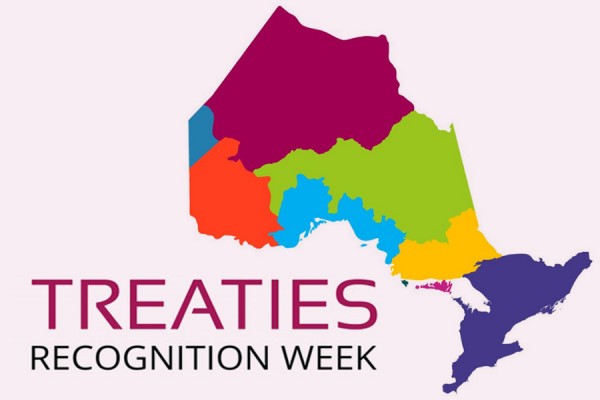 Trick or Treaty?
by
Obomsawin, Alanis, film director.; Obomsawin, Alanis, film producer.; Clarke, Annette, film producer.; National Film Board of Canada (Montreal), film producer.
Trick or Treaty?
by
Obomsawin, Alanis, film director.; Obomsawin, Alanis, film producer.; Clarke, Annette, film producer.; National Film Board of Canada (Montreal), film producer.
Wampums are visual memory keepers that help record history and communicate ideas. Beaded patterns represent a person, nation, event, invitation, shared values and understandings/agreements between two or more parties. Traditional wampum belts were used as covenants and petitions for understanding. Words spoken during an agreement are made into wampum to be used for ceremony, teaching, and reminders of law and values.
Dish With One Spoon Wampum Belt

The “Dish” or sometimes it is called the “Bowl” represents what is now southern Ontario (from the Great Lakes to Quebec and from Lake Simcoe into the U.S.). We all eat out of the Dish – all of us that share this territory – with only one spoon. That means we have to share the responsibility of ensuring the dish is never empty; which includes, taking care of the land and the creatures we share it with. Importantly, there are no knives at the table, representing that we must keep the peace.

Ontario is the first province in Canada to legislate the observance of an annual Treaties Recognition Week, demonstrating the continuing significance of the treaty relationship in Ontario.
Why Ontario marks Treaties Recognition Week:
First Nations were the original occupants of this land we call Ontario. Our shared history begins around 400 years ago, when Europeans first arrived.
Treaties between the British Crown (government) and Indigenous peoples were negotiated and signed with the intent of delivering mutual benefits. They signed as independent, self-governing nations.
Today, the Ontario government recognizes the wrongs of previous generations. The Journey Together plan outlines Ontario’s commitment to changing the future by rebuilding relationships based on trust and respect.
Part of that commitment includes educating Ontarians about the role treaties play in each of our lives and in our relationships with each other. Though they were signed more than a century ago, treaty commitments are just as valid today as they were then. Every Ontarian is a treaty person.
Ontario is covered by 46 treaties and other agreements.
(information taken from https://www.ontario.ca/page/treaties)
